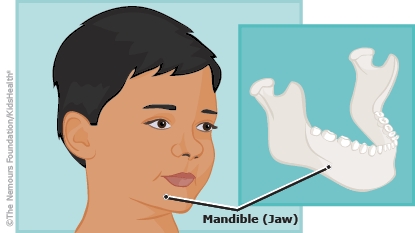The mandible is the lower jawbone. Treatment for a mandibular fracture (a broken jaw) depends on how developed the child's bones and teeth are, the type of broken bone, and whether there are other injuries. Your child had surgery to repair the broken jaw. The surgeon placed wires to keep the jaw still while it heals. The wires will stay in place for about 2–8 weeks. Rest, pain medicine, and a soft diet can help your child feel more comfortable while healing.

Follow your health care provider's instructions for:
- giving any pain medicines. These may include acetaminophen (Tylenol® or a store brand), ibuprofen (Advil®, Motrin®, or a store brand), or prescription pain medicine. Some pain medicines include the same or similar ingredients. To avoid giving too much, give the medicines exactly as your health care provider recommends.
- when your child can go back to school, sports, and other activities
- how to care for any wires
- the best way to clean the inside of your child's mouth
- follow-up visits with the plastic surgeon, oral-maxillofacial surgeon, dentist, or other specialist
- any jaw movement exercises your child should do
Your health care provider will give you wire cutters. Keep these close by in case your child vomits or has trouble breathing and the wires need to be cut.
Feeding Your Child
- If your child's jaw is secured shut, they will need to get all their nutrition through a straw. Give your child plenty of liquids and puréed (blended until thin) food (such as soups, pasta, or cooked fruit or vegetables).
- If your child's jaw isn't secured shut, they still need a soft diet. Give them plenty of liquids and soft foods that do not need to be chewed, such as yogurt, applesauce, cottage cheese, scrambled eggs, pudding, smoothies, and mashed potatoes. You can also give them puréed foods.
- Ask your health care provider if your child should also have nutrition drinks (such as PediaSure®, Ensure®, or a store brand).

What problems can happen from a broken jaw? Even when repaired with surgery, a broken jaw sometimes can lead to:
- problems with how the jawbone grows that can make one side of the face look different from the other
- dental problems
- infection of the jawbone
- problems with the joint that connects the jawbone to the skull (the temporomandibular joint)
- long-lasting pain
- obstructive sleep apnea (pauses in breathing while sleeping)




